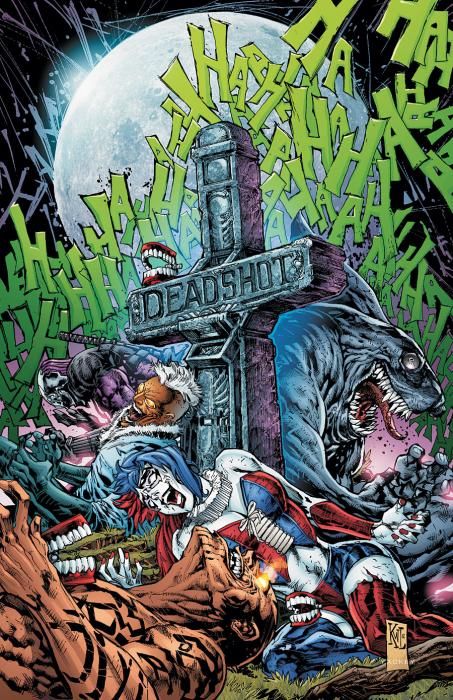By virtue of having their title be the current home to the character of Harley Quinn, Adam Glass and Fernando Dagnino get to join the "Death of the Family" crossover of the Batman titles with "Suicide Squad" #14. So why is it, then, that part of the issue ends up being the least interesting?
For readers who wanted to know how Harley Quinn ended up in "Batman" #13-14 (instead of locked up with the rest of the Squad), this issue answers that question early on thank to a sudden Joker attack in the middle of Deadshot's funeral. Unfortunately, there's no real originality or excitement to that scene; it doesn't feel necessary to either "Suicide Squad" or "Death of the Family" to know exactly how she ended up free. Likewise, by the time we finally return to Harley (post-"Batman" #14) her next confrontation also feels very sedate and a little unimaginative. "Death in the Family" (in "Batman" at least) has felt a little less standard than what we're getting here.
The saving grace, though, is everything else that happens in "Suicide Squad" #14. Amanda Waller and Boomerang's comments about Deadshot at his funeral say a lot about the two characters, and the fall-out from Black Spider's betrayal (and the brainwashing of the rest of the team) promises a lot of interesting stories ahead. It's nice to see Yo-Yo's bizarre encounter with King Shark getting a follow up, and El Diablo's continuing internal conflict seems even more volatile than before. In short, it's the sort of story that I've been reading "Suicide Squad" for, and I'm glad that narrative wasn't pushed aside entirely for the crossover.
Dagnino's art feels a little uneven this month. The Joker's new look is definitely the most problematic part of the visuals; instead of looking like his old face has been stretched across his head, it comes across more as a series of bandages. It never quite looks right, and his confrontations with Harley in general feel a little limp. Once again, though, it's the rest of the Squad's scenes that get the better push. El Diablo's eruption in his cell might only be one page long but it looks good (and colorist Matt Yackey helps bring it to life), and a simple conversation between Amanda Waller and Mia Visyak has good body language and that brings to life the relationship between the two.
"Suicide Squad" in general is a fun comic, but this detour feels like a slight derailment of the general momentum of the title. Fortunately the pieces that are able to continue on keep the book moving well enough, and hopefully "Death of the Family" might even add in a few new regular readers to the title, too. It's not bad, but it's certainly been a lot better.

